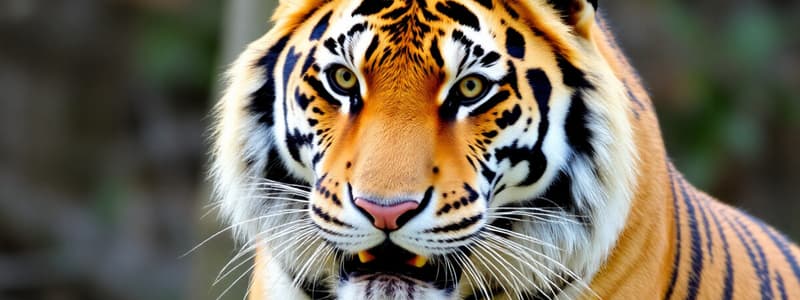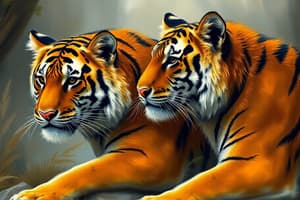Podcast
Questions and Answers
What is a primary reason for the Siberian tiger's low hunting success rate?
What is a primary reason for the Siberian tiger's low hunting success rate?
- Their large size makes them easily detectable by prey.
- Their hunting grounds have a scarcity of suitable prey.
- Despite their physical capabilities, successful kills occur only about 10% of the time. (correct)
- They lack the necessary skills and techniques for hunting in the snow.
Which of the following adaptations most directly aids the Siberian tiger in traversing snowy terrain?
Which of the following adaptations most directly aids the Siberian tiger in traversing snowy terrain?
- Their pale orange fur blends with the snowy surroundings.
- Their ability to leap long distances helps navigate drifts.
- Their large paws prevent sinking in the snow. (correct)
- Their thick fur provides insulation against the cold.
Besides Russia, where can small populations of Siberian tigers be found?
Besides Russia, where can small populations of Siberian tigers be found?
- Southern China and Japan
- Western China and South Korea
- Northern China and Mongolia
- Eastern China and North Korea (correct)
How does the Siberian tiger's tapetum lucidum enhance its hunting capabilities?
How does the Siberian tiger's tapetum lucidum enhance its hunting capabilities?
What is the primary function of papillae on a Siberian tiger's tongue?
What is the primary function of papillae on a Siberian tiger's tongue?
What is one of the camouflage adaptations the Siberian tiger uses?
What is one of the camouflage adaptations the Siberian tiger uses?
Which factor does not contribute to the endangerment of the Siberian tiger population?
Which factor does not contribute to the endangerment of the Siberian tiger population?
What is the approximate weight range of a Siberian tiger?
What is the approximate weight range of a Siberian tiger?
Flashcards
Siberian Tiger Size
Siberian Tiger Size
The largest cat on Earth, up to 10 feet long and 700 pounds heavy.
Siberian Tiger Population
Siberian Tiger Population
Fewer than 500 Siberian tigers remain in the wild, mainly in Russia.
Adaptations to Cold
Adaptations to Cold
Siberian tigers are built for extreme cold with long, thick fur and large paws.
Camouflage Features
Camouflage Features
Signup and view all the flashcards
Hunting Skills
Hunting Skills
Signup and view all the flashcards
Diet Capacity
Diet Capacity
Signup and view all the flashcards
Threats to Existence
Threats to Existence
Signup and view all the flashcards
Enhanced Night Vision
Enhanced Night Vision
Signup and view all the flashcards
Study Notes
Siberian Tiger
- The largest feline on Earth, reaching up to 10 feet in length and weighing up to 700 pounds.
- Fewer than 500 Siberian tigers remain in the wild. Approximately 400 inhabit Russia's birch forests, with others dispersed in Eastern China and North Korea.
- Adapted to frigid climates, enduring temperatures as low as -40°F.
- Large paws providing traction on snowy surfaces, preventing sinking.
- Wide stripes used for camouflage in forests during warmer months.
- Pale orange winter coat blends in with snowy environments.
- White stomach and chest aid in concealment and warmth.
- Fur significantly thicker and longer than species like Sumatran and Bengal tigers.
- Excellent stalkers, capable of 20-foot leaps for ambushes.
- More active during the night, despite not being strictly nocturnal.
- Tapetum lucidum, a reflective layer, enhances night vision six times beyond human capacity.
- 3-inch canine teeth capable of severing major arteries and shearing spinal cords.
- Powerful jaws crush the windpipe.
- Hunting success rate is only 1 in 10.
- Consume over 60 pounds of meat in one sitting, using papil (small hooks) on their tongues to remove flesh from bone.
- Human encroachment, logging, and settlements destroy vast tracts of their hunting grounds annually.
- Poaching has drastically reduced their numbers, devastating almost 85% of existing tigers.
- Authorities confiscate and destroy poaching contraband to combat the black market trade in tiger parts.
- Human intrusion endangers tigers and increases the possibility of dangerous human-tiger encounters.
Studying That Suits You
Use AI to generate personalized quizzes and flashcards to suit your learning preferences.





